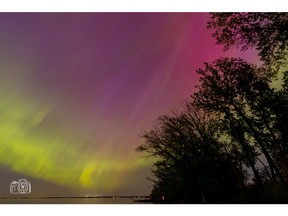
Article content
Skywatchers throughout North America got an eyeful the evening of May 10 but they had to be vigilant, because the intense Aurora Borealis created by unusual solar activity earlier in the week weren’t always the dancing lights that make the phenomenon so spectacular.
Nevertheless, professional and amateur photographers throughout southwestern Ontario have been posting photos of the aurora on social media.
Advertisement 2
Article content
Article content
Harrow photographer Donny Moore, who has some striking images posted on his Facebook page, travelled to Tremblay Beach on Lake St. Clair to view the Northern Lights, as they’re often called, in a dark sky, with little light intrusion.

“You could just see there’s almost like a curtain got pulled across the sky and as you adjusted to the darkness, you were able to see some of those colours,” he said.
Cameras were generally able to amplify the colours if they were set on longer exposure times, he said.
“I think the photographs, they amplify because they’re taken over a longer exposure. I’ve taken five-and-six-second exposures, so they might highlight the colour.”
The lights first appeared as a slight mist overhead, he said.
“Being this far south, I would never expect to be able to get the aurora overhead. I would have, at the best, expected to see them on the horizon. But this is right overhead. So you had that misty colour.”
Any kind of light pollution made it difficult to see the aurora, said Moore.
“Your eyes really do have to adjust for 15 minutes or so. If you’re looking down at the screen of a phone … your eyes are always adjusting.”
Article content
Advertisement 3
Article content
Moore, who likes to highlight vistas around Essex County, had shot the Northern Lights in the past so he knew what to look for.
“It just got darker and darker you start to see … a fine green mist. But you would have to be really focused,” he said.

To some, it may have appeared like a cloud overhead. “If you watched that bit of cloud, it would have changed quite rapidly. So rather than disappear the cloud kind of bounced across the sky.”
Moore shot the display with a Canon R6, with a 16-35mm lens at F2.8 The ISO was typically under 1000 once it got really bright, he said.
But he also successfully shot the aurora with his Google Pixel 7 cellphone, set on night mode, with five or six second exposures.
Video was harder to shoot. “I tried to shoot a bit of video with my phone (but) the auto focus bounced around and wasn’t really focused on anything. But my buddy beside me on his phone, his video looked good.”
Starr Livingston, head of the Royal Astronomical Society of Canada’s Windsor Centre, spent the evening at the group’s observatory in Comber.
Rather than the dancing light display that is so familiar to aurora watchers, it appeared more as a thin cloud in the sky and overhead, instead of from the north, said Livingston.
Advertisement 4
Article content
Many people missed the display as result, he said.
“It’s unusual that it moved farther south. What happened is, around 10:30 p.m., they started to disappear.
The aurora manifests as a ring around the north pole, and sometimes it grows or shrinks depending on solar activity, Livingston said.
Recommended from Editorial
Unusual solar activity earlier in the week – during which storms on the sun sent charged particles towards Earth, reacting with the planet’s magnetic field in the upper atmosphere – intensified the aurora.
That storm made the ring much bigger, so it could actually be seen in the southern United States, Livingston said.
Around 10:30 p.m., the ring moved farther south, so people in southwestern Ontario weren’t able to see much during that time. But the ring adjusted again and the aurora became visible in southwestern Ontario around 3. a.m., he said.
The website auroraforecast.com, predicted intense aurora activity again on Saturday and Sunday nights.

Article content





